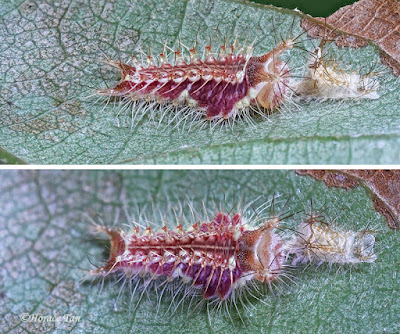Butterfly of the Month - May 2024
The Forget-Me-Not (Catochrysops strabo strabo)
A Forget-Me-Not perched on the top of a leaf to rest with its wings folded upright.
On this last day of May 2024, we feature a cryptic lookalike species from the Lycaenidae family. But before we delve into the details of this butterfly, I'd like to pay tribute to what NParks and the nature community in Singapore have done to push our island nation's vision to become a City In Nature. Last weekend, the community celebrated nature through its annual Festival Of Biodiversity. What is encouraging are the new groups set up by the younger generation of nature leaders. Nature is no longer the responsibility of a few old-guard "tree huggers" as the stewardship of the environment passes on to a group of young passionate enthusiasts.
The NParks and Lee Kong Chian Natural History Museum also launched the Singapore Red Data Book 3rd Edition at the Festival Of Biodiversity. The third and latest edition of the Singapore Red List is the most comprehensive one yet, with more than 7,300 species from 33 main taxa assessed in total, up from about 2,900 species from 26 taxa in the second edition. ButterflyCircle members are proud to have been a part of the authorship of the RDB3, contributing our assessments of the butterfly status based on the IUCN framework.
Back to our Butterfly of the Month for May 2024, we feature the Forget-Me-Not (Catochrysops strabo strabo). This species is a lookalike of its closely related cousin, the Silver Forget-Me-Not (Catochrysops panormus exiguus), the other species from the same genus that is also found in Singapore. The Foget-Me-Not is the rarer of the two species in Singapore.
The male of the Forget-Me-Not is lilac blue above with a very thin marginal border, whilst the female is pale whitish blue with broad black borders on both wings. The underside is pale greyish-buff with the usual Lycaenidae streaks and spots. There is an orange-crowned black tornal spot on the hindwing with a pair of white tipped filamentous tails.
Key difference between the Silver Forget-Me-Not and the Forget-Me-Not is the position of the costal spot in the underside of the forewing
A costal spot that is placed midway between the cell spot and the post-discal fascia distinguishes between the Forget-Me-Not and the very similar Silver Forget-Me-Not. The eyes of the species are jet black and the white-haired palpi gives the butterfly an appearance of an unshaven face. The antennae are black-and-white banded. and the tips of the antennal clubs are orange.
The butterfly is usually restless in flight and erratic, but stops to rest with its wings folded upright on the tops of foliage. At times, both sexes may be observed to sunbathe with their wings partially opened to show off their uppersides. The species is well-distributed, and found in open wastelands as well as the fringes of the nature reserves.
The males of the Forget-Me-Not can sometimes be encountered to puddle at damp footpaths and streambanks.
Males of the Forget-Me-Not are sometimes observed to puddle at damp footpaths and streambanks together with other species of butterflies. The caterpillars of the Forget-Me-Not have been bred on Pueraria phaseoloides in Singapore, a host plant that it also shares with the Silver Forget-Me-Not. The species is widely distributed across the region, from Sri Lanka and India, all the way to New Guinea.
Text by Khew SK : Photos by Khew SK, Koh CH, Loke PF, Nelson Ong, Jonathan Soong and Tan TS.
























































